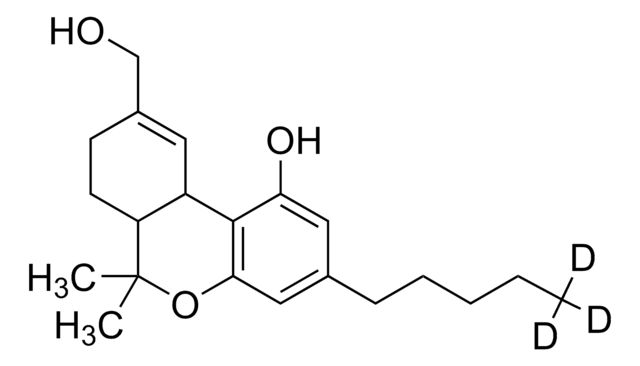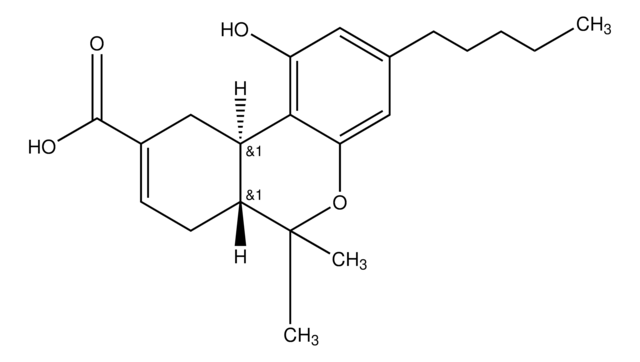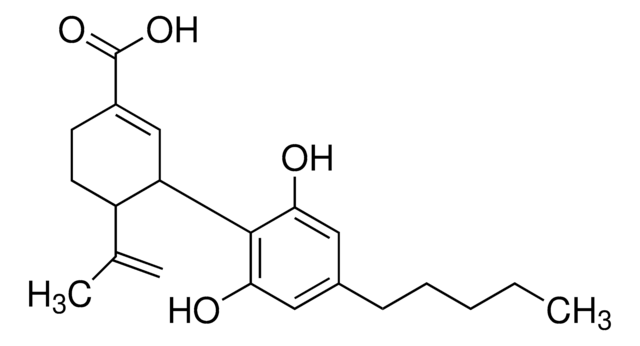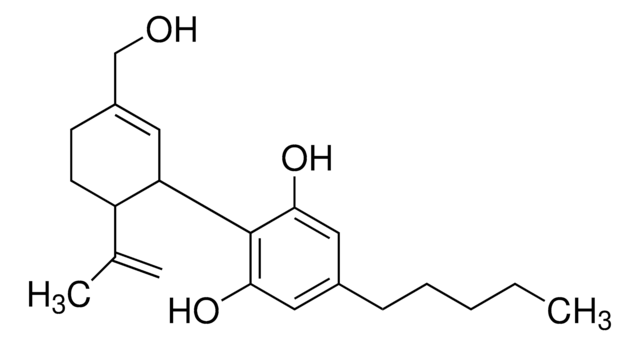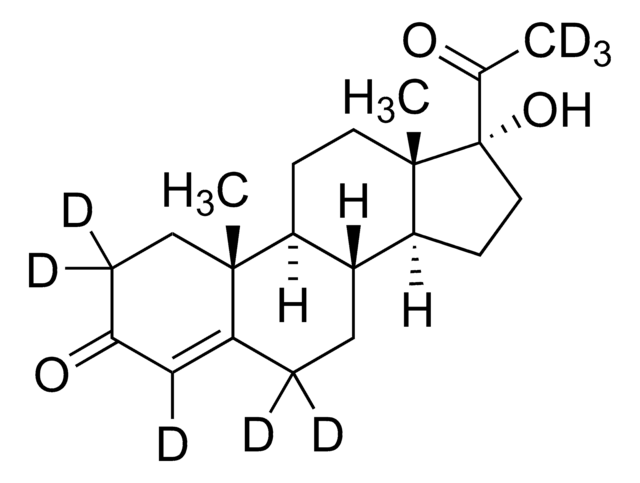H-027
(±)-11-Hydroxy-Δ9-THC solution
1.0 mg/mL in methanol, ampule of 1 mL, certified reference material, Cerilliant®
About This Item
Recommended Products
grade
certified reference material
Quality Level
form
liquid
feature
Snap-N-Spike®/Snap-N-Shoot®
packaging
ampule of 1 mL
manufacturer/tradename
Cerilliant®
drug control
psicótropo (Spain); Decreto Lei 15/93: Tabela IIB (Portugal)
concentration
1.0 mg/mL in methanol
technique(s)
gas chromatography (GC): suitable
liquid chromatography (LC): suitable
application(s)
cannabis testing
forensics and toxicology
format
single component solution
storage temp.
2-8°C
SMILES string
OC1=CC(CCCCC)=CC2=C1C3C=C(CO)CCC3C(O2)(C)C
InChI
1S/C21H30O3/c1-4-5-6-7-14-11-18(23)20-16-10-15(13-22)8-9-17(16)21(2,3)24-19(20)12-14/h10-12,16-17,22-23H,4-9,13H2,1-3H3
InChI key
YCBKSSAWEUDACY-UHFFFAOYSA-N
Looking for similar products? Visit Product Comparison Guide
General description
Application
- Quantification of cannabidiol and Δ9-tetrahydrocannabinol in addition to the identification of minor cannabinoids from human plasma samples using ultra-performance liquid chromatography (UHPLC) combined with triple quadrupole mass spectrometry following a liquid-liquid extraction
- Liquid chromatography-tandem mass spectrometry (LC-MS/MS) method-based determination of 10 cannabinoids in oral fluid samples following their solid phase extraction (SPE)
- Analysis of Δ9-Tetrahydrocannabinol (Δ9-THC) and its three metabolites in plasma and urine samples by gas chromatography (GC) coupled to triple quadrupole mass spectrometer
- Development of an automated sample preparation method based on solid phase extraction (SPE) to determine ∆9-tetrahydrocannabinol (THC) and its three primary metabolites in a variety of matrices, such as serum, saliva, and urine using liquid chromatography-mass spectrometry (LC-MS)
- Simultaneous determination of cannabinoids and their metabolites in human serum samples by an atmospheric-pressure chemical ionization gas chromatography-tandem mass spectrometry (APGC-MS/MS)
Features and Benefits
- Fully characterized under ISO/IEC 17025 and ISO 17034 accreditation
- Accompanied with a comprehensive Certificate of Analysis (CoA) with data on stability, homogeneity, accuracy of concentration, uncertainty, and traceability
- Rigorously tested through real-time stability studies to ensure accuracy and shelf life
- Gravimetrically prepared using qualified precision balances to ensure minimal uncertainty
- Flame sealed under argon into ampoules for long-term shelf life
- Offered in a convenient, DEA-exempt format to improve laboratory efficiency
Legal Information
related product
Signal Word
Danger
Hazard Statements
Precautionary Statements
Hazard Classifications
Acute Tox. 3 Dermal - Acute Tox. 3 Inhalation - Acute Tox. 3 Oral - Flam. Liq. 2 - STOT SE 1
Target Organs
Eyes
Storage Class Code
3 - Flammable liquids
WGK
WGK 1
Flash Point(F)
49.5 °F - closed cup
Flash Point(C)
9.7 °C - closed cup
Regulatory Listings
Regulatory Listings are mainly provided for chemical products. Only limited information can be provided here for non-chemical products. No entry means none of the components are listed. It is the user’s obligation to ensure the safe and legal use of the product.
FSL
Group 4: Flammable liquids
Alcohols
Hazardous rank II
JAN Code
H-027-CC:
H-027-1ML:4548173330433
Choose from one of the most recent versions:
Certificates of Analysis (COA)
Sorry, we don't have COAs for this product available online at this time.
If you need assistance, please contact Customer Support.
Already Own This Product?
Find documentation for the products that you have recently purchased in the Document Library.
Our team of scientists has experience in all areas of research including Life Science, Material Science, Chemical Synthesis, Chromatography, Analytical and many others.
Contact Technical Service
